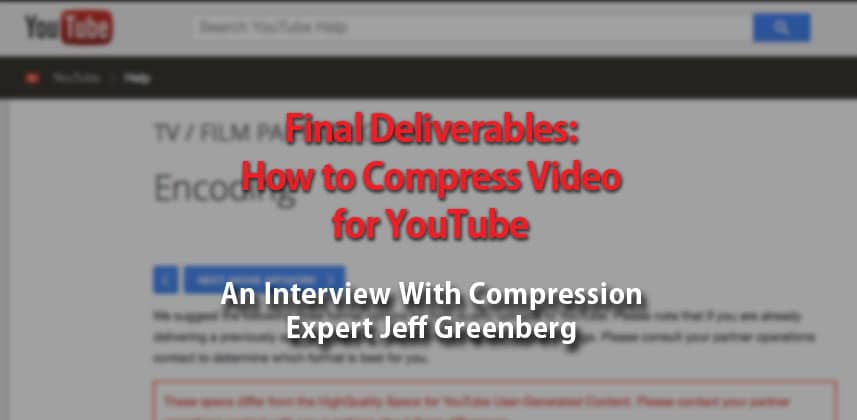Final Deliverables: Compressing for YouTube or Vimeo
Ripped from the Tao Color Correction Home Study
This Insight is from my old Home Study program over on Taoofcolor.com. In that Home Study, the final Lesson is on Deliverables. And one of the deliverables I talk about is YouTube, and I interviewed an expert on this topic, Jeff Greenberg. I enjoyed his interview so much that I thought it should be shared here on MixingLight.com.
Why is this topic being discussed on a website dedicated to color correction? As a professional Owner / Operator colorist, I’ve found it necessary to understand how to compress videos for YouTube upload. It’s a frequent client request for a deliverable, and I want that product to faithfully reproduce what I’m seeing in the grading suite as closely as possible.
In truth, throughout my career, I’ve found compressing for YouTube to be a frustrating exercise. It usually involves endless tweaking inside multiple compression software with endless test uploads and endless visual comparisons.
As part of the Color Correction Home Study, I decided to revisit this topic and develop a solid suggestion for my members on how to specifically compress videos for YouTube.
After completing a bunch of testing on my own – I decided to enlist the help of the one person I know who has spent an enormous amount of time developing expertise in compression… and almost as much time teaching it to other professionals. That person? Jeff Greenberg.
Jeff helps me deliver a very simple, easy-to-remember rule to compress video for YouTube as part of a deliverable package.
Interview: Jeff Greenberg
After you log in to this website (not a member? Sign up for a 7-Day Test Drive) you’ll be able to hear my 30+ minute Skype call with Jeff, where we dig into two overall topics:
- Compressing video for YouTube as a final client deliverable
- Understanding h.264 compression options
If you want to reach out to Jeff with questions or thank him for this interview, you can find him on his Twitter handle: @filmgeek
He’s always happy to interact.
Compressing for YouTube and Vimeo
In most of this interview, I’m asking Jeff specifically about YouTube as a deliverable – but what he says about YouTube can also be applied to Vimeo. But the truth is, if our clients want their videos to be found by Google, they need to put them on YouTube. Most of my clients understand this, and YouTube is almost always our target video streaming deliverable, hence its emphasis here in this discussion.
YouTube: Two Instruction Sets
One of the most fascinating lessons I’ve learned from Jeff is that YouTube actually has two sets of ‘compression specifications’: One targeted at Consumers and one targeted at Professionals.
Their rationale? Consumers want the YouTube experience to be fast, easy, and brainless. Consumers are more concerned with instant gratification. Professionals will tolerate longer uploads and processing times if it means even a small increase in final image quality.
In the Show Notes below, you’ll find the links to these two sets of instructions. Listen to the podcast to hear Jeff, and I emphasize what this means for us as professional content creators.
Compression 101
Also, in this interview, I dig into two core Compression concepts when using tools like Apple Compressor or Adobe Media Encoder for creating h.264 videos:
1. Which should I choose as my h.264 profile: Baseline / Main / High?
2. When should I use 2-pass VBR versus 1-pass VBR? Are there times when 1-pass will give us higher quality than 2-pass?
Jeff offers a solid rule-of-thumb for when you should choose 1-pass VBR over 2-pass VBR.
Show Notes
At several times in this interview, Jeff shares a few links with me, which I click on, and we discuss. Here are those links:
• YouTube User Upload Specs: This page lists two data rates for h.264. The first is a very low data rate and then the recommended data rate for ‘enterprise quality internet connections’. These data rates are almost the same as the YouTube Professional specs for h.264 deliverables and dovetail nicely with what Jeff says concerning 1-pass VBR and 2-pass VBR.
• YouTube Professional Upload Specs: Jeff and I are both unclear if uploading ProResHQ without being a ‘certified’ professional channel partner results in their processing following a higher-quality path versus their User upload path. But we both agree, any User – as long as you’ve verified your YouTube account to upload videos longer than 15 minutes, YouTube seems to be quite able to process your ProResHQ uploads.
• Wikipedia h.264 Profiles: What are the different h.264 Profiles and what do they mean? Scroll down to see a handy-dandy chart.
• Wikipedia h.264 Levels: Jeff introduces us to the concept of h.264 Levels in this podcast, this is a link to the chart.
Credits
• Audio editing and sweetening by Tom Parish. Thanks Tom!


